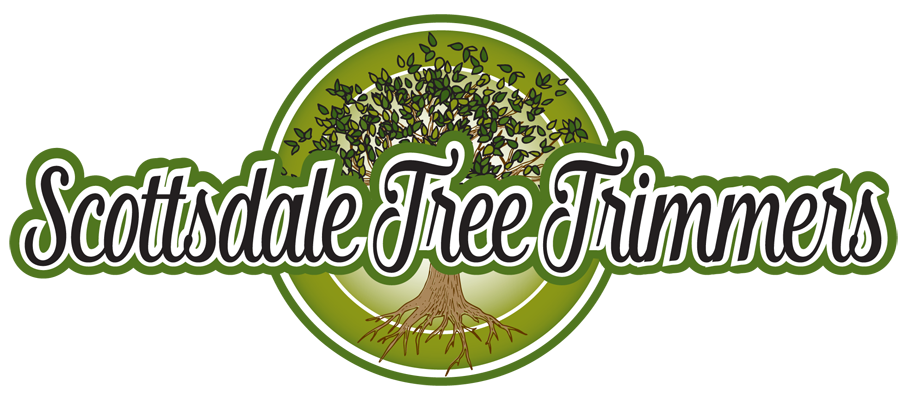
Queen Palm
Growing up to 50 feet tall, the Queen Palm tree is a beautiful evergreen tree that will provide years of enjoyment, if properly cared for. Queen Palm trees need fertilized (4) times per year to avoid health problems and sickness, such as the sick Queen Palm tree shown. Without regular Manganese Sulphate, Magnesium Sulphate & Sulfur fertilizer treatments, Queen Palm tree owners can expect to have Queen Palm trees in declining health. Queen Palm trees that are not regularly fertilized are susceptible to airborne fungal infections, Manganese deficiency, Magnesium deficiency, Bud Rot, and even death of your Queen Palm tree.
This article explains how to care for Queen Palms, fertilizer for Queen Palms, Queen Palm trimming, and other crucial How To information to help your healthy or sick Queen Palm tree.
Below is an example of a Queen Palm tree dying; if your tree is suffering and you're in the Gilbert, Scottsdale or Phoenix-metro area, you can call one of our tree doctors for help before it's too late!
Palm Tree Care
Queen palms need a lot of moisture in their soil, so don't let your Queen Palm struggle during dry periods. In addition to watering on a regular basis, Queen Palm owners should also fertilize Queen Palms 3 times per year, using granular Manganese Sulphate, Magnesium Sulphate & Sulfur fertilizer in bore-hole pockets within 12"-18" of the Queen Palm trunk, and a liquid Copper Fungicide treatment (if required), applied to the very top of the crown of your Queen Palm tree. Another part of Queen Palm care includes keeping grass & lawns a safe distance from the trunk to prevent decay from overspray from sprinklers, and also semi-annual trimming of your Queen Palm tree, to prevent excessive wind resistance during wind gusts and storms.
Queen Palms should be fertilized (3) times per year with these Fertilizers:
Manganese Sulphate
Magnesium Sulphate
Sulfur
If you properly fertilize your Queen Palm trees every 4 to 6 months with Manganese Sulphate, Magnesium Sulphate & Sulfur, your Queen Palm trees can recover from sickness, grow strong and healthy new fronds, and be protected from certain Bacterial and Fungal infections.

Queen Palm Care
This article explains how to properly care for Queen Palm trees, through regular and proper fertilization, watering techniques, and also how to get in touch with a tree doctor if you'd like these life-saving Queen Palm treatments handled for you, by a pro.
By the way, if you're Queen Palm tree is showing any of the health symptoms in the video below, you should schedule a consultation with a Certified Arborist right away. If you live in Scottsdale, Gilbert Az or the Phoenix metro area, call one of our tree doctors ASAP!
Care For Palms
To properly care for Queen Palm trees, it's first important to understand what creates a happy and healthy environment for your Queen Palm, then, reward your Queen Palm with those best-in-care practices.
King Palm vs Queen Palm
Queen Palm trees and King Palms often are mistaken for one another. Despite similar features (and even closer names), King Palms and Queen Palm trees have many differences that are important to know about. It's crucial to learn how to care for these two palm species, since both the Queen and King Palm have very different nutrient and habitat requirements. Just how important is learning how to properly care for a Queen Palm tree? If a Queen Palm tree is mistaken for a King Palm and neglected of it's quarterly Copper Fungicide & Manganese Sulphate & Magnesium Sulphate treatments, it could easily die.
Queen Palms Are From Brazil
Queen Palm trees are native to tropical climates in South America (they originate from Brazil), so it's helpful to think about the environment that Queen Palm trees come from. In the tropical, jungle environment of the Rainforests, Queen Palms enjoy high humidity, lower temperatures, and soil rich in nutrients, such as Manganese (Mn). These nutrient rich soils are not available in many places which Queen Palms have become popular in landscapes, such as the desert environment of Arizona.

King Palms Are From Australia
King Palm trees are native to Australia (far, far away from the tropical Rainforests of Brazil). Even though Queen Palms and King Palm trees look very similar, there are major differences between these two species of palm trees.

Differences Between King & Queen Palms
Queen Palm trees have gray colored trunks, that if left unpruned and manicured, will become hidden and obscured by old, hanging dead fronds. On the other hand, King Palm trees have smooth, multi-colored trunks that stay naturally clean, since the King Palm is a self-trimming palm tree.

Another key difference between King & Queen Palm trees is that Queen Palms require large amounts of Manganese & Magnesium Sulphate, and on a regular basis (think every 4 months). It is recommended that Queen Palms receive this vital treatment once a seson (along with liquid Copper Fungicide in the tops of the crowns).
Queen Palm Fertilizer
In desert environments (think Arizona), soils can be very poor and devoid of the crucial mineral and nutrients that Queen Palms need to survive, and thrive. Queen Palm trees will struggle and decline in health if they are not regularly and properly fertilized, but make sure that this dual-fertilization process is either done using the specific instructions of an I.S.A. Certified Arborist, or that it's performed by a tree service professional. That way, any health issues, watering techniques or fertilization techniques can be identified, and a tree-specific care plan can be crafted for your valuable Queen Palm trees.
Here's an example of how the harsh, mineral deficient soil of Arizona can wreak havoc on the health of Queen Palm trees.

If you need more info on growing palms indoors, check out this resource.
Fertilizer for Queen Palms

When it comes to Queen Palm Fertilizer, there is a right way and a wrong way to fertilize your Queen Palm trees.
The best way to fertilize your Queen Palms is to use a granular Manganese fertilizer, spread evenly around the base of the tree's trunk, applying the fertilizer granules in a thick donut shape. Don't be afraid about applying too much Manganese granules, because granular fertilizer is a slow-release formula, designed to seep into your Queen Palm's root system every time that your tree is watered.
The worst way to fertilize your Queen Palm trees is to use any type of 'fertilizer spikes', because fertilizer spikes come with many problems, and may be a danger to your Queen Palm.

How might fertilizer spikes be dangerous to your Queen Palm tree? Because fertilizer spikes dissolve very slowly over time (if at all), they may not give your Queen Palm tree the vital minerals that it needs to grow new, strong and healthy fronds.
"Fertilizer Spikes can kill your Queen Palm tree. Instead of providing fertilizer for Queen Palms, they deprive your Queen Palm tree of the nutrients it needs to survive and thrive. Fertilizer Spikes can even contribute to causing Palm Frizzle Top."Certified Arborist Dan A. Riggs
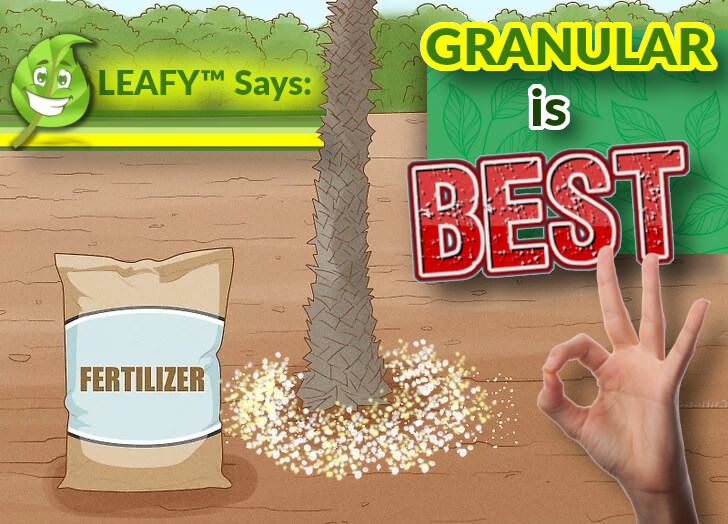
Properly caring for a sick or dying Queen Palm tree is crucial to its survival. Granular fertilizer might seem old-fashioned, but it is still the best way to get life-saving minerals into your Queen Palm's root system, and fast. But most homeowner's want to hire a pro tree service for this task, since in many cases, over 20-30lbs. of fertilizer may be used if there are several Queen Palm trees that need treatment.

The best way for homeowners to get large amounts of crucial Manganese into the soil is by hiring a Certified Arborist, using the "bore-hole" method. This method applies the crucial Manganese, Magnesium & Sulfur fertilizers directly into the root zone of the Queen palm tree (where it's needed most). If you'd rather take the DIY approach (with less results), a homeowner should start by mounding large amounts of Manganese Sulphate & Magnesium Sulphate granules around the base of each Queen Palm tree. The Manganese & Magnesium Sulphate mounds should resemble the shape of a very large donut, and should be about 2-3 feet in diameter, depending on factors such as the age, height and health of the Queen Palm tree. But remember, it is easy for a homeowner to mistakenly kill their Queen Palm trees by either over fertilizing (or under fertilizing) their dying Queen Palms. (Ask an Arborist for help to be on the safe side; Queen Palm trees are expensive to replace!)

If a homeowner insists on the DIY method (as opposed to hiring a Certified Arborist), use the following method for best results. After the Manganese & Magnesium Sulphate 'donut ring' has been mounded around the base of the Queen Palm tree, it's important to get this life-saving mineral into the soil, and fast. The easiest way to do this is by using a garden hose to dissolve the Manganese & Magnesium Sulphate granules so that they can be absorbed by your Queen Palm's root system. Other ways (that are not recommended) are to use your home's irrigation system (slow and not predictable), or mother nature's rain to dissolve the granules (also, not easy to forecast), and can prolong the disease of your palm tree.
Arizona's Best Palm Tree Food

But Manganese Sulphate, Manganese Sulphate & Sulfur fertilization is only half of how to care for a Queen Palm. The second part of how to fertilize a Queen Palm tree is by applying large amounts of liquid Copper Fungicide directly into the very top of the crown of each Queen Palm tree. This Copper Fungicide treatment is crucial to the proper way to fertilize Queen Palm trees and fight palm diseases, and if left out of the treatment process, may endanger the life of your Queen Palm.
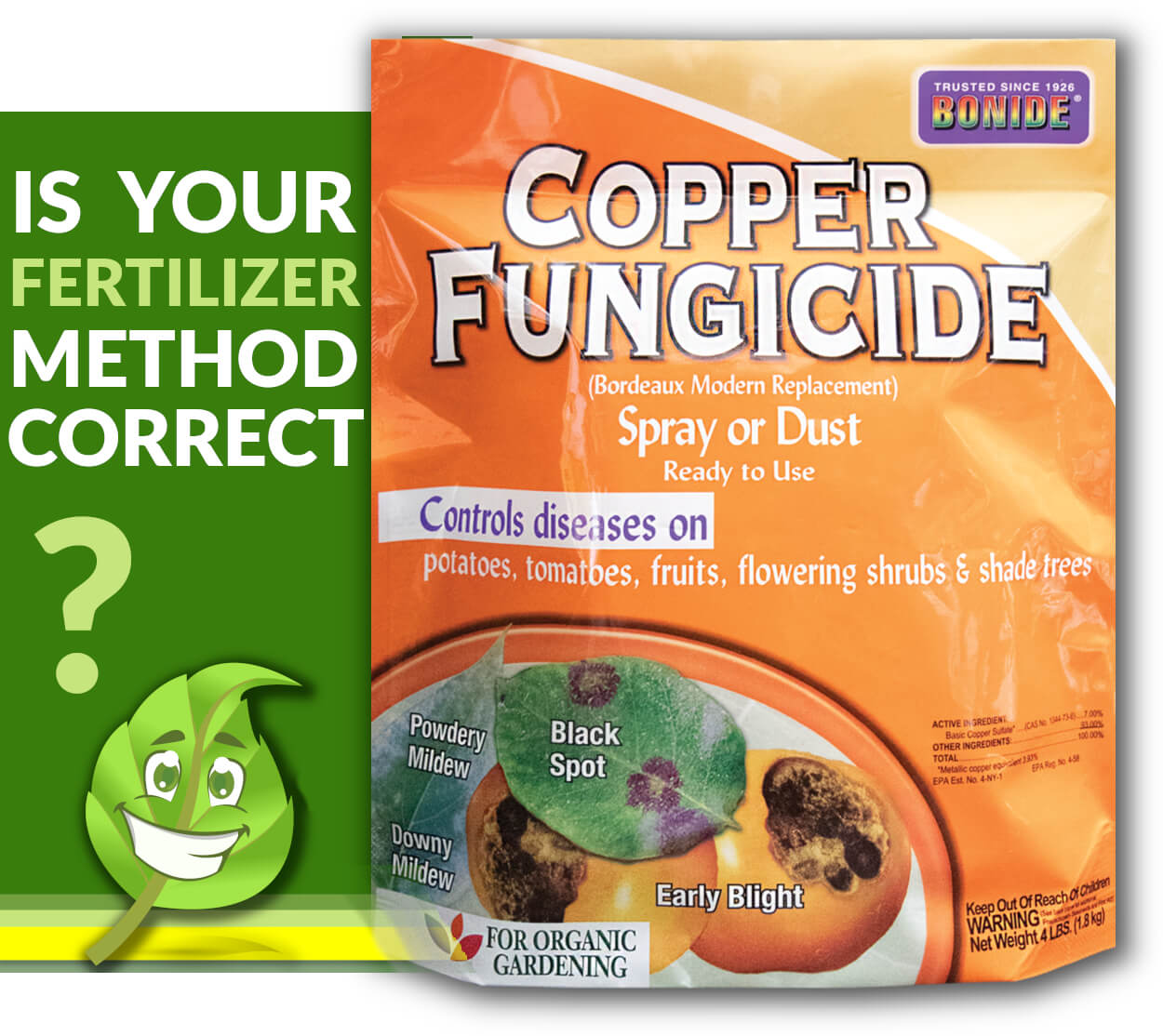
Want to see how healthy and beautiful a Queen Palm tree can look just 6-8 weeks following a treatment?
I'll bet you do.
Check-out this short & sweet video of a healthy Queen Palm tree after being fertilized by a pro tree service: ⬇️
Some Arborists will recommend soil-injected liquid fertilization. The problem with this fast-acting method is that nearly all of those nutrients are depleted from your Queen Palm tree's soil within 30 days of being applied.
What does that mean for your Queen Palm tree? If you pay only for expensive soil-injection fertilization treatments, your Queen Palm will starve after 30 days go by. (Keep your Queen Palm trees fed & happy!)
You can also learn about Queen Palm leaf spots or leaf blights by checking out this resource.
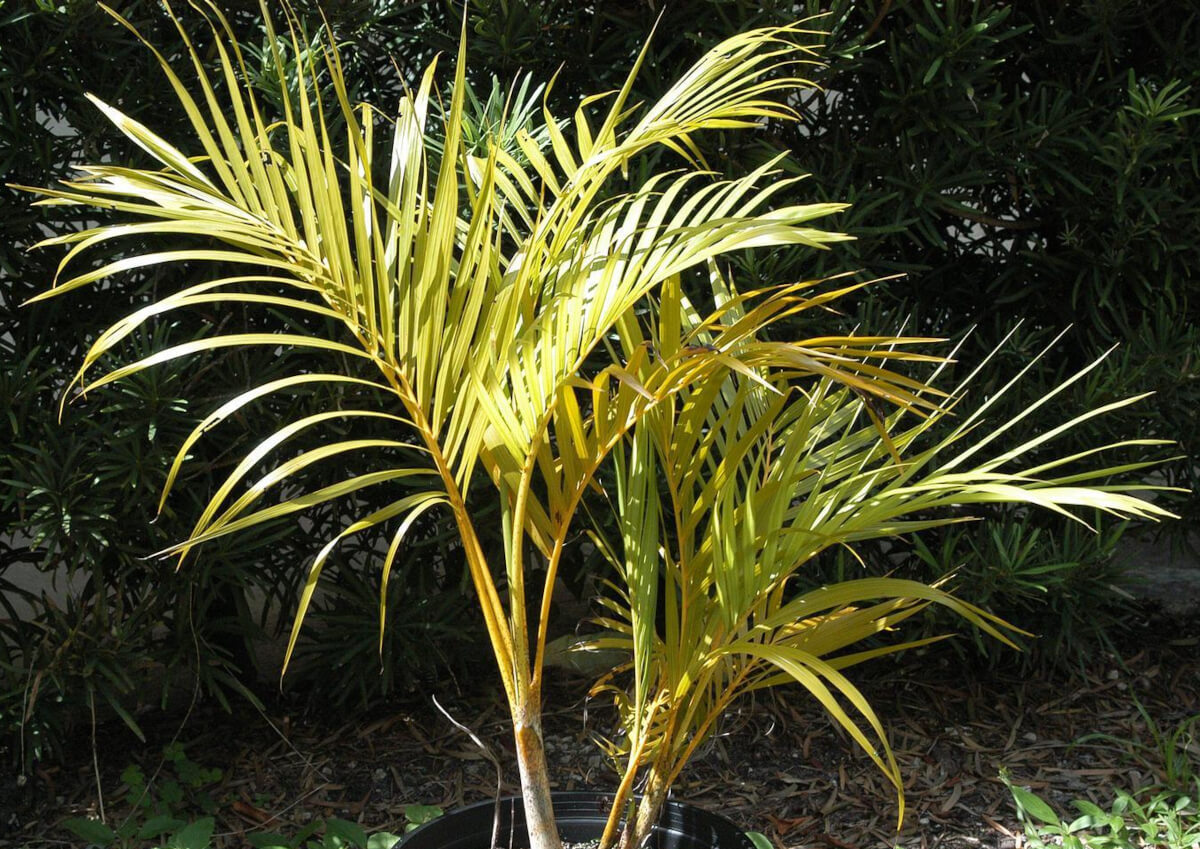
Why Are My Queen Palms Turning Yellow?
Are your Queen Palm fronds turning yellow? In addition to likely needing a proper Copper Fungicide, Micro-Injection, or Manganese, Magnesium & Sulfur treatments, yellowing of a Queen Palm's crown can indicate a couple of things:
Manganese Sulphate Deficiency
Magnesium Sulphate Deficiency
Sulfur Deficiency
Iron Deficiency
Improper Watering
Insufficient Light Conditions
Queen Palm tree health problems can be seen through a variety of health symptoms. Some of these include poor growth, sparse or stunted foliage, wilting, and even death of the crown of the Queen Palm. There are other environmental factors that can contribute to the yellowing or decline of Queen Palm trees, such as high temperatures, drying winds, low soil moisture, and nutrient deficient soil.
Palm Frizzle Top

"Manganese & Magnesium Sulphate Deficiency is the biggest killer of Queen Palm trees in Arizona, nothing else comes close. This nutrient deficiency is nothing to ignore, and requires a carefully dosed Manganese, Magnesium & Sulfur treatment for palm trees."Certified Arborist Dan A. Riggs
Do the fronds of your Queen Palm tree look stunted or frizzled, like someone forgot to turn the oven off, but left the cake baking? Your Queen Palms have a fungal infection commonly referred to as Frizzle Top, which is caused by a lack of proper nutrition that weakens your Queen Palm tree's immune system, allowing your Queen Palm to become susceptible to airborne fungal infections.
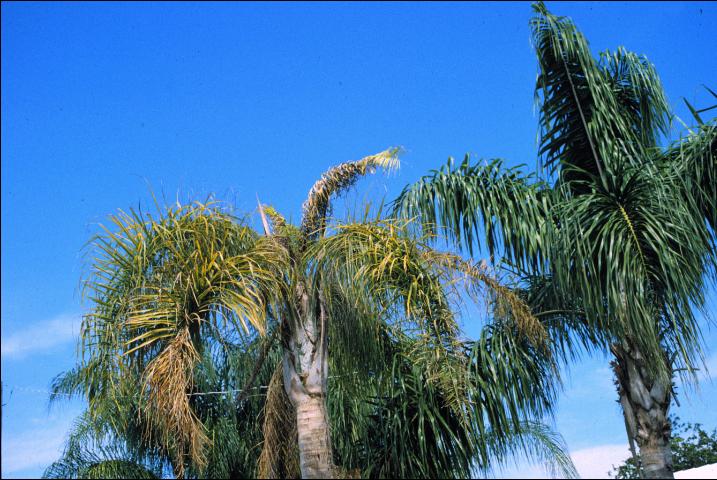
Here's an example of a Queen Palm tree with palm Frizzle Top, caused by a palm fungus or Manganese & Magnesium deficiency that can be deadly to Queen Palm trees if not treated 3 times per year:
"Queen Palm trees want to fight their own battles. Through proper Manganese, Magnesium & Sulfur treatments for palm trees 3 times per year, we strengthen Queen Palms immune systems to fend off palm fungus infections and grow stronger, year after year."Certified Arborist Dan A. Riggs
Queen Palm Diseases

Do your Queen Palm trees look like this?
(Or worse?!)
what is wrong with my queen palm ?
Environmental factors that harm Queen Palm trees:
💉 Nutrient Deficiencies
Manganese & Copper Fungicide (Bordeaux) treatments are needed 3-4 times per year to maintain healthy Queen Palm trees.
🌬 Drying Winds
Protect your Queen Palm trees from drying winds by applying 4-6 inches of wood chips, bark or mulch over the Root Zone to prevent evaporation. .
🔥 High Temperatures
Harsh climate can be combatted with a proper watering schedule & complete fertilization 3-4 times per year.
💧 Low Soil Moisture
Combat low soil moisture by properly watering your Queen Palm on a watering schedule.
If your Queen Palm trees are sick or in need of Fertilization treatments and you live in Gilbert Az, Scottsdale or anywhere in the Phoenix area, call our tree doctors & tree care service pros today at (480) 332-0462 to schedule your Free Quote to fertilize, treat, and save your sick Queen Palm trees.
Need Queen Palm Treatment ?
Our tree care Arborists may be able to SAVE your Queen Palm tree!
